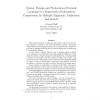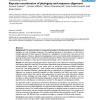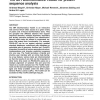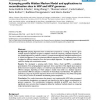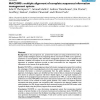JCB
2002
14 years 6 months ago
2002
We describe a new algorithm for protein classi cation and the detection of remote homologs. The rationale is to exploit both vertical and horizontal information of a multiple alig...
JUCS
2000
14 years 6 months ago
2000
This article introduces the idea that information compression by multiple alignment, unification and search (ICMAUS) provides a framework within which natural language syntax may ...
BMCBI
2004
14 years 6 months ago
2004
Background: For the purposes of finding and aligning noncoding RNA gene- and cis-regulatory elements in multiple-genome datasets, it is useful to be able to derive multi-sequence ...
CANDC
2005
ACM
14 years 6 months ago
2005
ACM
We propose an algorithm of global multiple sequence alignment that is based on a measure of what we call information discrepancy. The algorithm follows a progressive alignment ite...
BMCBI
2005
14 years 6 months ago
2005
Background: Two central problems in computational biology are the determination of the alignment and phylogeny of a set of biological sequences. The traditional approach to this p...
NAR
2006
14 years 6 months ago
2006
The MPI Bioinformatics Toolkit is an interactive web service which offers access to a great variety of public and in-house bioinformatics tools. They are grouped into different se...
NAR
2006
14 years 6 months ago
2006
HHsenser is the first server to offer exhaustive intermediate profile searches, which it combines with pairwise comparison of hidden Markov models. Starting from a single protein ...
NAR
2008
14 years 6 months ago
2008
Phylogenetic analyses are central to many research areas in biology and typically involve the identification of homologous sequences, their multiple alignment, the phylogenetic re...
BMCBI
2006
2006
A jumping profile Hidden Markov Model and applications to recombination sites in HIV and HCV genomes
14 years 6 months ago
Background: Jumping alignments have recently been proposed as a strategy to search a given multiple sequence alignment A against a database. Instead of comparing a database sequen...
BMCBI
2006
14 years 6 months ago
2006
Background: In the post-genomic era, systems-level studies are being performed that seek to explain complex biological systems by integrating diverse resources from fields such as...

